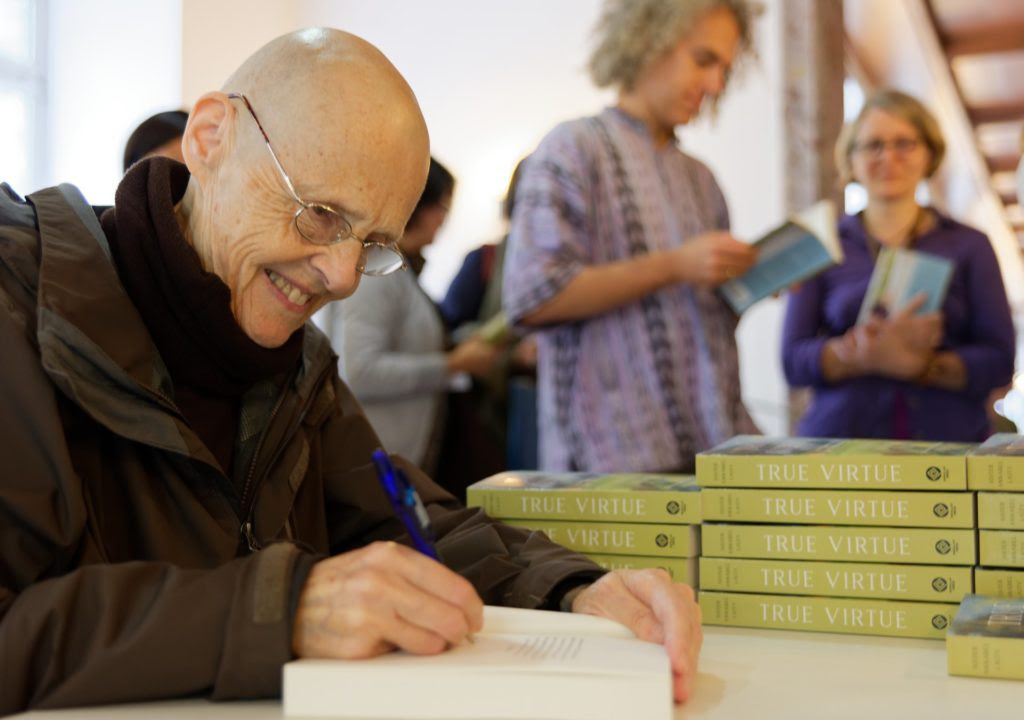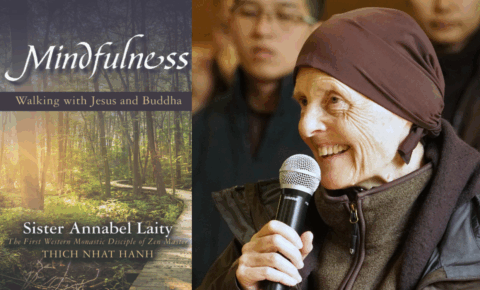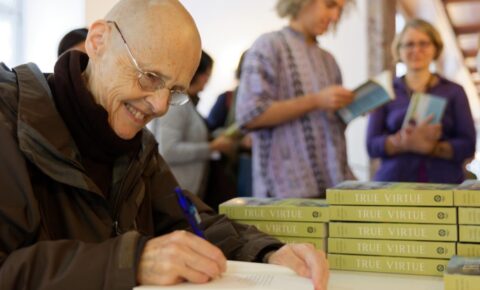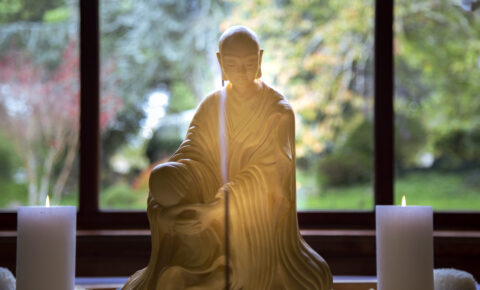An interview with Sister Annabel, editor and translator of a new book of Thich Nhat Hanh’s teachings, Enjoying the Ultimate
For Buddhists seeking perfection, the Sanskrit word “nirvana” is held as the unreachable goal. But in this definitive, direct translation of the Chinese Dharmapada by Zen Master Thich Nhat Hanh, nirvana is not what you think it is.
“Nirvana is our daily business,” Thich Nhat Hanh says. Based on talks given in his home monastery of Plum Village in France at the peak of his long teaching career, this book conveys Thich Nhat Hanh’s insights on the 36 verses on nirvana in the Chinese Dharmapada. Described there as “the absence of notions that cause suffering,” we discover that nirvana can be experienced at any time. Previously unavailable in English, these teachings on the experiential path which can help us touch nirvana are an “instant classic” for Buddhists and meditation practitioners.
In celebration of this release, editor and translator Sister Annabel Laity sat down and answered some questions about the message of Enjoying the Ultimate, misconceptions about Nirvana, and why Zen Master Thich Nhat Hanh chose this chapter to teach to his students.

Sister Annabel Laity (Chan Duc, True Virtue) was born in England, she studied Classics and Sanskrit. In 1988, in India, she became the first Western person to be ordained as a monastic by Zen Master Thich Nhat Hanh. Her autobiography, True Virtue: The Journey of an English Buddhist Nun, was published in 2019.
Little is known in the West about the Chinese Dharmapada from which this text is taken. What does Enjoying the Ultimate offer to practitioners and students who are more familiar with the Pali Dhammapada?
Sister Annabel Laity: There are no complete translations of the Chinese Dharmapada in English. The Pali Dhammapada has 26 chapters and the Chinese Dharmapada has 39. The Chinese Dharmapada is more difficult to translate since it is extremely concise and the Chinese language of the third century CE is so different. The Pali is much easier to translate, and that is why we are more familiar with it. If we were to translate the Chinese Dharmapada word by word, it would make no sense at all. That is why it needs not just a scholar who is conversant with the history of Buddhist thought and practice, but a scholar who has also attained deep insight into the Buddhist teachings through their own practice. The Venerable Thich Nhat Hanh fulfills both these qualifications.
The Chinese Dharmapada includes the Nirvana chapter, which the Pali Dhammapada does not. What makes this chapter unique?
Sister Annabel Laity: Whether it is the Pali Dhammapada or the Chinese Dharmapada, all the verses were originally spoken by the Buddha in the language the Buddha spoke. They were then translated into Pali, Sanskrit, or other Indian dialects and then into Chinese. The Buddha’s teachings on nirvana can be found scattered in many different places in the Chinese, the Pali, and the Sanskrit canons of Buddhism. Then they were gathered into one place by certain Buddhist scholars and made into the Nirvana Chapter of the Dharmapada. Here we have a succinct summary of the Buddhist teachings on nirvana.
Nirvana is right here and now, you can realize it for yourself
Sister Annabel Laity
Why do you think Master Thich Nhat Hanh chose this chapter to teach to his students?
Sister Annabel Laity: One reason is that this chapter is not at all easy to understand and without a commentary we could feel very lost trying to understand it. Another reason is that, whether we are Buddhist or not, we all have an idea about nirvana, but we may have very little idea of how we can practice to experience nirvana for ourselves. Zen Master Thich Nhat Hanh teaches applied Buddhism and wants to make these teachings available to us so that we can apply them in our daily lives.
Many people have widely different notions of Nirvana. What are some misconceptions about Nirvana that you hope this book corrects?
Sister Annabel Laity: The main misconception is that nirvana is only attainable after you die and it has nothing to do with life. The Buddha taught clearly a nirvana in this very world and in this very life (drstadharmanirvana). It is equivalent to the idea in Christianity that you can only be in heaven or the Kingdom of God when you die, while teachings in the Gospels tell us that the kingdom of heaven is right here. Another misconception is that the human psyche-soma is an insurmountable obstacle stopping us from realizing nirvana. In fact, with daily practice we can use our body and mind to transform our anger, craving, and ignorance, and so experience nirvana. Another misconception is that nirvana is to be found somewhere else in space and time and we need to go somewhere else to touch nirvana. In fact nirvana is always available to us. It is we who are not available to the nirvana that is always present.
There is a long history of practitioners writing commentaries on Buddhist texts. What significance do you see in adapting the Buddha’s teachings to today’s world through new commentaries?
Sister Annabel Laity: We live in an age that needs a global spirituality. Too long religious ideas and practices have been a source of division and hatred. New commentaries, such as this one, show how anyone—whether they call themselves Buddhist or not—can practice to touch nirvana in the present moment. We hope that this commentary can help to bring humanity closer together.
For many, a large obstacle is the seeming incompatibility between engagement with the world and a perception of nirvana as distant, abstract, and immaterial. How does this book fit into the efforts of Plum Village to shift that perception?
Sister Annabel Laity: In our time, it is not possible to go and live in a cave on the mountain and practice alone. We are engaged from the time we wake up until the time we go to sleep: engaged with our family, our community, our society. Brotherhood and sisterhood are the qualities that bring hope for our world. We cannot do it alone. We need a sangha, a community of practice, where those of us who hold to the principles of understanding and love can work together to bring about inner and outer change at the same time. Every time one person is able to transform some affliction, they do it not just for themselves but for their family, their society, and the world. Nirvana is right here and now, you can realize it for yourself—and it needs your body as well as your mind to do that.
This interview was first published on the Parallax Press website and is reposted here with permission.
Enjoying the Ultimate is available from Parallax Press which is the non-profit publisher founded by Thich Nhat Hanh.







Share Your Reflections